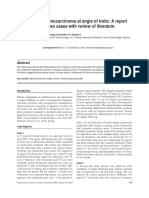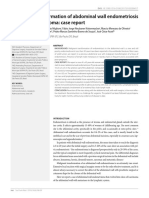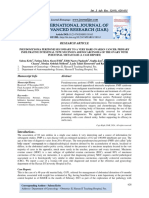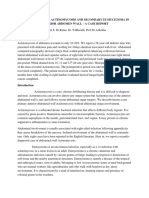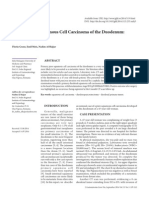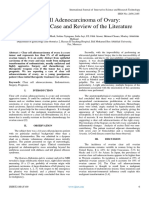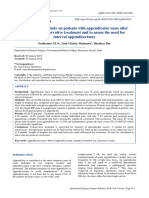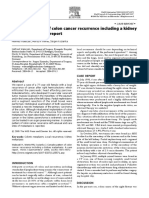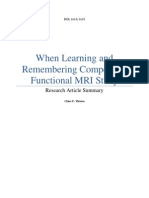Professional Documents
Culture Documents
Mucinous Neoplasm of Appendix Treatment
0 ratings0% found this document useful (0 votes)
8 views3 pagesThis study aims to treatment for mucinous neoplasm
of appendix
Copyright
© © All Rights Reserved
Available Formats
PDF, TXT or read online from Scribd
Share this document
Did you find this document useful?
Is this content inappropriate?
Report this DocumentThis study aims to treatment for mucinous neoplasm
of appendix
Copyright:
© All Rights Reserved
Available Formats
Download as PDF, TXT or read online from Scribd
0 ratings0% found this document useful (0 votes)
8 views3 pagesMucinous Neoplasm of Appendix Treatment
This study aims to treatment for mucinous neoplasm
of appendix
Copyright:
© All Rights Reserved
Available Formats
Download as PDF, TXT or read online from Scribd
You are on page 1of 3
Volume 8, Issue 3, March – 2023 International Journal of Innovative Science and Research Technology
ISSN No:-2456-2165
Mucinous Neoplasm of Appendix: Treatment
Dr. Ratikant Narayan Raikar1, Dr. C.N Manoj Raj2 , Dr. Manjunath A P3 , Dr. Rahul Raikar*
1
Associate Professor, Department of General Surgery, AIMS, B G Nagara, India
2
Post Graduate, Department of General Surgery, AIMS, B G Nagara, India
3
Post Graduate, Department of General Surgery, AIMS, B G Nagara, India
*Assistant Professor, Department of General Surgery, AIMS, B G Nagara, India
Abstract:- II. CASE SERIES
AIM:This study aims to treatment for mucinous neoplasm
of appendix A. Case 1
MATERIAL AND METHODS: A prospective descriptive A elderly obese female (BMI – 30.6 kg/m2) presented to
study was done in patient with history of pain abdomen the out-patient of surgery department in tertiary care center in
and distension presented to our hospital July 2021, with a pain abdomen since 6 months with no history
RESULTS: We provide an overview of the most recent of chronic cough/ tuberculosis as well as in close contacts. On
information and conflicts about the classification of AMNs, examination patient compliants of right ilac fossa pain with
clinical manifestations, and the effectiveness of rest of the physical examination being normal.
cytoreductive surgery and hyperthermic intraperitoneal Ultrasonography of abdomen and pelvis was performed which
chemotherapy (HIPEC) suggested sealed off appendicular perforation. The patient was
CONCLUSION: Appendiceal mucinous tumors are planned for an explorative laprotomy. Intra-operatively a
frequently an incidental finding. The treatment of this appendix was enlarged and peroration was seen at the tip of
disease depands on the Histologic tumor grade and the the appendix and appendecetomy was performed and
presence of peritoneal dissemination will determine specimen was sent for HPE and the wound was closed with
surgery which includes, from appendectomy to primary interrupted sutures. HPE report suggested of low
cytoreductive surgery.The tretment for Low-grade grade mucinous carcinoma of appendix. The scar healed by
tumors includes resection of the primary site in early stage primary intension and the patient was followed up for a
disease, or peritoneal debulking and for advance stage duration of 3 months having no recurrence.
includes HIPEC .While treatment for high-grade tumors
include debulking surgery and HIPEC with or without B. Case 2
preoperative chemotherapy . A elderly male (BMI – 28.9 kg/m2) presented to the out-
patient of surgery department in tertiary care center in
Keywords:- Mucinous Neoplams of Appendix, Appendix, December 2021, with abdominal distension and pain abdomen
Treatment. since 3months. Patient has no history of chronic cough/
tuberculosis as well as in close contacts. On examination
I. INTRODUCTION patient Local guarding was seen in right ilac fossa with
minimal ascitis fluid with bowel sound present.
These are the rare tumors accounting for less than 1% of Ultrasonography of abdomen was performed which suggested
all cancers. The way the symptoms manifest themselves can Appendicular perforation with minimal ascitis and CECT
vary, but the most common symptoms is right iliac fossa Abdomen was done which showed appendicular perforation
abdominal pain, which can be misdiagnosed as acute with periappoendicular collection with ascitis with no
appendicitis. Lowgrade tumors that are limited to the appendix lymphnode enlargement. The patient was planned for an
are typically benign. On the other hand, tumors that have explorative laprotomy. Intra-operatively appendicular
invaded the appendiceal wall or have a high degree of atypia perforation was seen at the tip with mucin deposition in the
may grow rapidly and are classified as adenocarcinomas. abdomen and appendecetomy was done and specimen was
sent for HPE and the wound was closed with primary
Types of Mucinous appendiceal tumors are 1) mucinous interrupted sutures. HPE report suggested of low grade
cystadenoma (MC), 2)mucinous tumors of uncertain mucinous carcinoma of appendix. The scar healed by primary
malignant potential (M-UMP), 3)mucinous tumors with low intension with no recurrence during the follow up period of 2
malignant potential (M-LMP) and 4)mucinous months.
adenocarcinoma(MA).The treatment of AMN is largely based
on stage and histology.
IJISRT23MAR1015 www.ijisrt.com 1228
Volume 8, Issue 3, March – 2023 International Journal of Innovative Science and Research Technology
ISSN No:-2456-2165
C. Case 3 Localized AMNs
An elderly male presented to the out-patient of surgery The majority of surgical research implies that a
department in tertiary care centre in May 2022 with a pain straightforward appendectomy is sufficient for tumors
abdomen since 6 months and abdominal distension and pain demonstrating only local malignancy since the incidence of
abdomen since 3months. Physical examination patient Local nodal spread of well-differentiated localized appendiceal
guarding was seen in right ilac fossa with minimal ascitis fluid malignancies is less than 2%.In case of positive margins after
with bowel sound present. The rest of the physical appendecetomy, Right hemicolectomy should be considered
examination was under normal limits with no other swelling/ as the next step of mangement .The same is to be considered
lump noted in the axilla, groin or the neck. Ultrasonography of for peri-appendiceal tumors . Tumor size of 2 cm or larger,
abdomen abdomen was performed which suggested high grade histology, or tumor that invades through the
Appendicular perforation with minimal ascitis and CECT muscularis propria, criteria for right hemicolectomy include
Abdomen was done which showed appendicular perforation the following: (1) degree of cellular undifferentiation,(2)
with periappoendicular collection with ascitis with no increased mitotic activity, (3)Appendicular base involvement
lymphnode enlargement . Patient was planned for surgery – (4) metastasis to lymph nodes, or (e) tumor size more than 2
Explorative Laparotomy. Intra-operatively appendicular cm. As mentioned above features are risk factor for local
perforation was seen at the tip with mucin deposition in the recurrences, thus supporting right hemicolectomy.
abdomen and appendecetomy was done excised specimen was
sent for HPE and the wound was closed with primary Treatment of AMN with Peritoneal Metastasis
interrupted sutures. HPE report suggested low grade mucinous In these patient main stay of tretment includes repeated
carcinoma of appendix. The scar healed by primary intension drainage of the mucinous ascites and serial debulking
with no recurrence during the follow up period of 6 months. surgeries.they were also study which showed intraperitoneal
chemotherapy with debulking surgery improved the condition
III. DISCUSSION of the patient.
Appendiceal mucinous neoplasms account for 0.4%–1% IV. CONCLUSION
of all gastrointestinal malignancies, According to estimates,
there are 0.12 cases of AMN per 1 million people each year. Staging and histology type are needed for treatment . The
The majority of appendiceal tumor patients (70–74%) are tretment for Low-grade tumors includes resection of the
white, and 50%–55% of them are women. Over time, no primary site in early stage disease, or peritoneal debulking and
discernable demographic change has been seen. for advance stage includes HIPEC . Treatment of high-grade
tumors options include debulking surgery and HIPEC, with or
The most frequent clinical manifestation in early stage without preoperative chemotherapy.
disease is right lower abdomen pain, which the patient may
experience as a result of the appendix being distended by REFERENCES
mucus. If the tumor blocks the appendiceal orifice and
ruptures, there may be appendiceal perforation.
[1]. McCusker ME, Cote TR, Clegg LX et al. Primary
The buildup of mucous ascites in the peritoneum causes malignant neoplasms of the appendix: A populationbased
abdominal distension in advanced stages of the disease. study from the surveillance, epidemiology and end-
Chronic stomach pain, weight loss, anemia, infertility, and results program, 1973–1998. Cancer 2002;94:3307–
newly developed umbilical or inguinal hernias are additional 3312.
clinical manifestations for this stage. [2]. Smeenk RM, van Velthuysen ML, Verwaal VJ et al.
Appendiceal neoplasms and pseudomyxoma peritonei: A
population based study. Eur J Surg Oncol 2008;34:196–
Ronnett's classification system was then updated and 201.
simplified into low- and high-grade carcinoma, where any [3]. Rokitansky K, Swaine WE, Sir Sieveking EH, Moore
mucinous epithelium beyond the muscularis mucosa is CH, Day GE. A Manual of Pathological Anatomy.Vol. 2.
unambiguous evidence of an invasive appendiceal Philadelphia, PA: Blanchard and Lea, 1855;24:100–118.
malignancy. Peritoneal mucinous carcinomatosis (PMCA) and [4]. Elting AW. IX. Primary carcinoma of the vermiform
disseminated peritoneal adenomucinosis (DPAM) were appendix, with a report of three cases. Ann Surg
further divided into three forms by Bradley et al. 1903;37:549–574.
well-differentiated mucinous adenocarcinoma, grade 1 of [5]. Carr NJ, McCarthy WF, Sobin LH. Epithelial
(DPAM), noncarcinoid tumors and tumor-like lesions of the
mucinous adenocarcinoma, grade 2 of 3 (PMCA-I type), appendix. A clinicopathologic study of 184 patients with
high-grade mucinous adenocarcinoma, grade 3 of 3 a multivariate analysis of prognostic factors. Cancer
(PMCA type). 1995;75:757–768.
[6]. Gupta S, Parsa V, Adsay V et al. Clinicopathologic
alanalysis of primary epithelial appendiceal neoplasms.
Med Oncol 2010;27:1073–1078.
IJISRT23MAR1015 www.ijisrt.com 1229
Volume 8, Issue 3, March – 2023 International Journal of Innovative Science and Research Technology
ISSN No:-2456-2165
[7]. Young RH. Pseudomyxoma peritonei and selected other
aspects of the spread of appendiceal neoplasms. Semin
Diagn Pathol 2004;21:134–150.
[8]. Collins DC. 71,000 human appendix specimens. A final
report, summarizing forty years’ study. Am J Proctol
1963;14:265–281.
[9]. Connor SJ, Hanna GB, Frizelle FA. Appendiceal tumors:
Retrospective clinicopathologic analysis of appendiceal
tumors from 7,970 appendectomies. Dis Colon Rectum
1998;41:75–80.
[10]. Jemal A, Siegel R,Ward E et al. Cancer statistics, 2009.
CA Cancer J Clin 2009;59:225–249.
[11]. Ito H, Osteen RT, Bleday R et al. Appendiceal
adenocarcinoma: Long-term outcomes after surgical
therapy. Dis Colon Rectum2004;47:474–480.
[12]. Bradley RF, Stewart JH 4th, Russell GB et al.
Pseudomyxoma peritonei of appendiceal origin: A
clinicopathologic analysis of 101 patients uniformly
treated at a single institution, with literature review. Am
J Surg Pathol 2006;30:551–559.
[13]. Garg PK, Prasad D, Aggarwal S et al. Acute intestinal
obstruction: An unusual complication of mucocele of
appendix. Eur Rev Med Pharmacol Sci 2011;15:99–102.
[14]. Rutledge RH, Alexander JW. Primary appendiceal
malignancies: Rare but important. Surgery
1992;111:244–250.
[15]. Reid MD, Basturk O, Shaib WL et al. Adenocarcinoma
ex-goblet cell carcinoid (appendiceal-type crypt cell
adenocarcinoma) is a morphologically distinct entity
with highly aggressive behavior and frequent association
with peritoneal/intra-abdominal dissemination: An
analysis of 77 cases. Mod Pathol 2016;29:1243–1253.
[16]. Kabbani W, Houlihan PS, Luthra R et al. Mucinous and
nonmucinous appendiceal adenocarcinomas: Different
clinicopathological features but similar genetic
alterations. Mod Pathol 2002;15: 599–605.
[17]. Rouchad A, Gayet M, Bellin MF. Appendiceal
mucinous cystadenoma. Diagn Interv Imaging.
2014;95:113–6.
[18]. Van den Heuvel MG, Lemmens VE, Verhoeven RH, de
Hingh IH. The incidence of mucinous appendiceal
malignancies: a population based study. Int J Colorectal
Disease. 2013;28:1307–10.
[19]. Lai CW, Yue CT, Chen JH. Mucinous
cystadenocarcinoma of the appendix mimics acute
appendicitis. Clin Gastroenterol Hepat. 2013;11.
[20]. McGory M, Maggard M, Kang H, O’Connel J, Ko C.
Malignancies of the appendix: beyond case series
reports. Dis Colon Rectum. 2005;48:2264–71
IJISRT23MAR1015 www.ijisrt.com 1230
You might also like
- Atlas of Early Neoplasias of the Gastrointestinal Tract: Endoscopic Diagnosis and Therapeutic DecisionsFrom EverandAtlas of Early Neoplasias of the Gastrointestinal Tract: Endoscopic Diagnosis and Therapeutic DecisionsFrieder BerrNo ratings yet
- Adenocarcinoma at Angle of Treitz: A Report of Two Cases With Review of LiteratureDocument3 pagesAdenocarcinoma at Angle of Treitz: A Report of Two Cases With Review of LiteratureRijal SaputroNo ratings yet
- Rare Case of Diffuse Malignant Peritoneal MesotheliomaDocument5 pagesRare Case of Diffuse Malignant Peritoneal MesotheliomaDragos Viorel ScripcariuNo ratings yet
- v1Document8 pagesv1Pulasthi KanchanaNo ratings yet
- Adult Intussussception Int J Student Res 2012Document3 pagesAdult Intussussception Int J Student Res 2012Juan De Dios Diaz-RosalesNo ratings yet
- Peritoneal Nodules, A Rare Presentation of Gastrointestinal Stromal Tumour - A Case ReportDocument2 pagesPeritoneal Nodules, A Rare Presentation of Gastrointestinal Stromal Tumour - A Case ReporteditorjmstNo ratings yet
- Synchronous Pancreatic Neuroendocrine Tumor and Pancreatic Cyst A Case ReportDocument4 pagesSynchronous Pancreatic Neuroendocrine Tumor and Pancreatic Cyst A Case ReportWorld Journal of Clinical SurgeryNo ratings yet
- International Journal of Surgery Case ReportsDocument4 pagesInternational Journal of Surgery Case Reportsyongky sugandaNo ratings yet
- Skipidip Skipidap Colonic Hernia YyeewaghDocument4 pagesSkipidip Skipidap Colonic Hernia YyeewaghSu-sake KonichiwaNo ratings yet
- EchografyDocument6 pagesEchografyMiha ElaNo ratings yet
- Malignant Transformation of Abdominal Wall Endometriosis To Clear Cell Carcinoma: Case ReportDocument5 pagesMalignant Transformation of Abdominal Wall Endometriosis To Clear Cell Carcinoma: Case ReportfahubufezNo ratings yet
- Journal Reading Acute Pancreatitis SurgeryDocument17 pagesJournal Reading Acute Pancreatitis Surgeryimanda rahmatNo ratings yet
- Adult Abdominal Cystic Lymphangioma Revealed by Intra Peritoneal Hemorrhage A Case ReportDocument3 pagesAdult Abdominal Cystic Lymphangioma Revealed by Intra Peritoneal Hemorrhage A Case ReportInternational Journal of Innovative Science and Research TechnologyNo ratings yet
- Journal Homepage: - : IntroductionDocument4 pagesJournal Homepage: - : IntroductionIJAR JOURNALNo ratings yet
- Unexplained ascites sign of rare cancerDocument3 pagesUnexplained ascites sign of rare cancersandzatNo ratings yet
- Ray Coquard2018Document26 pagesRay Coquard2018Juan Daniel Serrano GuerreroNo ratings yet
- Purbadi-Peritoneal tuberculosis mimicking advanced ovarian cancer case report- Laparoscopy as diagnostic modality-2021-International Journal of Surgery Case ReportsDocument4 pagesPurbadi-Peritoneal tuberculosis mimicking advanced ovarian cancer case report- Laparoscopy as diagnostic modality-2021-International Journal of Surgery Case ReportsSulaeman Andrianto SusiloNo ratings yet
- 1 s2.0 S2210261221012268 MainDocument4 pages1 s2.0 S2210261221012268 Mainzenatihanen123No ratings yet
- Dnternational Federation of Gynecology and Obstetrics Staging of Endometrial CancerDocument4 pagesDnternational Federation of Gynecology and Obstetrics Staging of Endometrial CancerravannofanizzaNo ratings yet
- 1 s2.0 S2210261223004741 MainDocument5 pages1 s2.0 S2210261223004741 MainDevita SanangkaNo ratings yet
- Clinical Profile of Patients Undergoing PancreaticoduodenectomyDocument25 pagesClinical Profile of Patients Undergoing PancreaticoduodenectomyRoscelie KhoNo ratings yet
- GistDocument4 pagesGistMada IacobNo ratings yet
- 17-09-2019 Lower GI FINALDocument32 pages17-09-2019 Lower GI FINALNaima HabibNo ratings yet
- Primary Carcinoma of Fallopian Tube: Case Series Case ReportDocument4 pagesPrimary Carcinoma of Fallopian Tube: Case Series Case ReportChi NgôNo ratings yet
- Gastrointestinal 132Document8 pagesGastrointestinal 132Minerva Medical Treatment Pvt LtdNo ratings yet
- 1 s2.0 S2210261218301822 MainDocument3 pages1 s2.0 S2210261218301822 Mainfatini hikariNo ratings yet
- US Diagnosis of Acute Appendicitis: PendahuluanDocument6 pagesUS Diagnosis of Acute Appendicitis: PendahuluanN4123 Ap UneNo ratings yet
- Adenocarcinoma of The Esophagogastric JunctionDocument9 pagesAdenocarcinoma of The Esophagogastric JunctionKiara GovenderNo ratings yet
- Abdomen FungusDocument7 pagesAbdomen FungusHAMMADNo ratings yet
- A Case of Primary Actinomycosis and Secondary Eumycetoma in Anterior Abdomen Wall - A Case ReportDocument7 pagesA Case of Primary Actinomycosis and Secondary Eumycetoma in Anterior Abdomen Wall - A Case ReportHAMMADNo ratings yet
- Fonc 13 1155233Document6 pagesFonc 13 1155233Setiaty PandiaNo ratings yet
- Sister Mary Joseph Nodule As Cutaneous.9Document3 pagesSister Mary Joseph Nodule As Cutaneous.9Fernando MartinezNo ratings yet
- s40792 018 0489 1Document7 pagess40792 018 0489 1Laura PredescuNo ratings yet
- Ultrasonography: A Cost - Effective Modality For Diagnosis of Rib Tuberculosis - A Case ReportDocument3 pagesUltrasonography: A Cost - Effective Modality For Diagnosis of Rib Tuberculosis - A Case ReportAdvanced Research PublicationsNo ratings yet
- MUCINOUS-ADENOCARCINOMA-FINALDocument16 pagesMUCINOUS-ADENOCARCINOMA-FINALritzy0997No ratings yet
- Casereports 18 125 PDFDocument6 pagesCasereports 18 125 PDFAstrianti Kusuma WardaniNo ratings yet
- Article - Laparoscopic Versus Open Surgery For Rectal Cancer (COLOR II) - Short-Term Outcomes of A Randomised, Phase 3 Trial - 2013Document9 pagesArticle - Laparoscopic Versus Open Surgery For Rectal Cancer (COLOR II) - Short-Term Outcomes of A Randomised, Phase 3 Trial - 2013Trí Cương NguyễnNo ratings yet
- Prikazi Slučajeva: Case ReportsDocument5 pagesPrikazi Slučajeva: Case ReportsJose GerardoNo ratings yet
- Diagnosis and Management of Klatskin Tumor: April 2010Document6 pagesDiagnosis and Management of Klatskin Tumor: April 2010Feby Kurnia PutriNo ratings yet
- Primary Pure Squamous Cell Carcinoma of The Duodenum: A Case ReportDocument4 pagesPrimary Pure Squamous Cell Carcinoma of The Duodenum: A Case ReportGeorge CiorogarNo ratings yet
- 48 Devadass EtalDocument4 pages48 Devadass EtaleditorijmrhsNo ratings yet
- Clear Cell Adenocarcinoma of Ovary About A Rare Case and Review of The LiteratureDocument3 pagesClear Cell Adenocarcinoma of Ovary About A Rare Case and Review of The LiteratureInternational Journal of Innovative Science and Research TechnologyNo ratings yet
- Primary Umbilical Endometriosis. Case Report and Discussion On Management OptionsDocument7 pagesPrimary Umbilical Endometriosis. Case Report and Discussion On Management Optionsari naNo ratings yet
- AppendicitisDocument3 pagesAppendicitisRindayu Julianti NurmanNo ratings yet
- Rare Peritoneal Tumour Presenting As Uterine Fibroid: Janu Mangala Kanthi, Sarala Sreedhar, Indu R. NairDocument3 pagesRare Peritoneal Tumour Presenting As Uterine Fibroid: Janu Mangala Kanthi, Sarala Sreedhar, Indu R. NairRezki WidiansyahNo ratings yet
- f194 DikonversiDocument5 pagesf194 DikonversiFarizka Dwinda HNo ratings yet
- Chipo ImagesDocument14 pagesChipo ImagespopNo ratings yet
- 2007-03 - Intestinal Autotransplantation For Adenocarcinoma of Pancreas Involving The Mesenteric Root - Our Experience and Literature Review PDFDocument3 pages2007-03 - Intestinal Autotransplantation For Adenocarcinoma of Pancreas Involving The Mesenteric Root - Our Experience and Literature Review PDFNawzad SulayvaniNo ratings yet
- The Robotic Approach For Enucleation of A Giant Esophageal LipomaDocument3 pagesThe Robotic Approach For Enucleation of A Giant Esophageal LipomaPatricia JaramilloNo ratings yet
- Rare Abdominal Wall Endometriosis Case ReportDocument3 pagesRare Abdominal Wall Endometriosis Case ReportwererewwerwerNo ratings yet
- Autopsy 10 4 E2020176Document7 pagesAutopsy 10 4 E2020176PriyakrishnaVasamsettiNo ratings yet
- Jurding 1Document7 pagesJurding 1Yuda DanangNo ratings yet
- Diagnosing Gastric Volvulus in Chest X-Ray: Report of Three CasesDocument4 pagesDiagnosing Gastric Volvulus in Chest X-Ray: Report of Three CasesSuraj KurmiNo ratings yet
- Gastrointestinal Stromal Tumor FirdausDocument8 pagesGastrointestinal Stromal Tumor FirdausFarizka FirdausNo ratings yet
- Ca GástricoDocument8 pagesCa GástricoAndrea Rosales Cid De LeonNo ratings yet
- International Journal of Surgery Case Reports: Adenocarcinoma in An Ano-Vaginal Fistula in Crohn's DiseaseDocument4 pagesInternational Journal of Surgery Case Reports: Adenocarcinoma in An Ano-Vaginal Fistula in Crohn's DiseaseTegoeh RizkiNo ratings yet
- Simple Conization and Lymphadenectomy For The Conservative Treatment of Stage IB1 Cervical Cancer. An Italian ExperienceDocument4 pagesSimple Conization and Lymphadenectomy For The Conservative Treatment of Stage IB1 Cervical Cancer. An Italian ExperienceKaleb Rudy HartawanNo ratings yet
- A Case Series of Pilonidal Sinus Over Anterior Chest WallDocument3 pagesA Case Series of Pilonidal Sinus Over Anterior Chest WallInternational Journal of Innovative Science and Research TechnologyNo ratings yet
- Complex Pattern of Colon Cancer Recurrence Including A Kidney Metastasis: A Case ReportDocument2 pagesComplex Pattern of Colon Cancer Recurrence Including A Kidney Metastasis: A Case Reportkangchih0331No ratings yet
- Primary Congenital Choledochal Cyst With Squamous Cell Carcinoma: A Case ReportDocument6 pagesPrimary Congenital Choledochal Cyst With Squamous Cell Carcinoma: A Case ReportRais KhairuddinNo ratings yet
- Comparatively Design and Analyze Elevated Rectangular Water Reservoir with and without Bracing for Different Stagging HeightDocument4 pagesComparatively Design and Analyze Elevated Rectangular Water Reservoir with and without Bracing for Different Stagging HeightInternational Journal of Innovative Science and Research TechnologyNo ratings yet
- Diabetic Retinopathy Stage Detection Using CNN and Inception V3Document9 pagesDiabetic Retinopathy Stage Detection Using CNN and Inception V3International Journal of Innovative Science and Research TechnologyNo ratings yet
- The Utilization of Date Palm (Phoenix dactylifera) Leaf Fiber as a Main Component in Making an Improvised Water FilterDocument11 pagesThe Utilization of Date Palm (Phoenix dactylifera) Leaf Fiber as a Main Component in Making an Improvised Water FilterInternational Journal of Innovative Science and Research TechnologyNo ratings yet
- Advancing Healthcare Predictions: Harnessing Machine Learning for Accurate Health Index PrognosisDocument8 pagesAdvancing Healthcare Predictions: Harnessing Machine Learning for Accurate Health Index PrognosisInternational Journal of Innovative Science and Research TechnologyNo ratings yet
- Dense Wavelength Division Multiplexing (DWDM) in IT Networks: A Leap Beyond Synchronous Digital Hierarchy (SDH)Document2 pagesDense Wavelength Division Multiplexing (DWDM) in IT Networks: A Leap Beyond Synchronous Digital Hierarchy (SDH)International Journal of Innovative Science and Research TechnologyNo ratings yet
- Electro-Optics Properties of Intact Cocoa Beans based on Near Infrared TechnologyDocument7 pagesElectro-Optics Properties of Intact Cocoa Beans based on Near Infrared TechnologyInternational Journal of Innovative Science and Research TechnologyNo ratings yet
- Formulation and Evaluation of Poly Herbal Body ScrubDocument6 pagesFormulation and Evaluation of Poly Herbal Body ScrubInternational Journal of Innovative Science and Research TechnologyNo ratings yet
- Terracing as an Old-Style Scheme of Soil Water Preservation in Djingliya-Mandara Mountains- CameroonDocument14 pagesTerracing as an Old-Style Scheme of Soil Water Preservation in Djingliya-Mandara Mountains- CameroonInternational Journal of Innovative Science and Research TechnologyNo ratings yet
- The Impact of Digital Marketing Dimensions on Customer SatisfactionDocument6 pagesThe Impact of Digital Marketing Dimensions on Customer SatisfactionInternational Journal of Innovative Science and Research TechnologyNo ratings yet
- A Review: Pink Eye Outbreak in IndiaDocument3 pagesA Review: Pink Eye Outbreak in IndiaInternational Journal of Innovative Science and Research TechnologyNo ratings yet
- Auto Encoder Driven Hybrid Pipelines for Image Deblurring using NAFNETDocument6 pagesAuto Encoder Driven Hybrid Pipelines for Image Deblurring using NAFNETInternational Journal of Innovative Science and Research TechnologyNo ratings yet
- Design, Development and Evaluation of Methi-Shikakai Herbal ShampooDocument8 pagesDesign, Development and Evaluation of Methi-Shikakai Herbal ShampooInternational Journal of Innovative Science and Research Technology100% (3)
- A Survey of the Plastic Waste used in Paving BlocksDocument4 pagesA Survey of the Plastic Waste used in Paving BlocksInternational Journal of Innovative Science and Research TechnologyNo ratings yet
- Cyberbullying: Legal and Ethical Implications, Challenges and Opportunities for Policy DevelopmentDocument7 pagesCyberbullying: Legal and Ethical Implications, Challenges and Opportunities for Policy DevelopmentInternational Journal of Innovative Science and Research TechnologyNo ratings yet
- Hepatic Portovenous Gas in a Young MaleDocument2 pagesHepatic Portovenous Gas in a Young MaleInternational Journal of Innovative Science and Research TechnologyNo ratings yet
- Explorning the Role of Machine Learning in Enhancing Cloud SecurityDocument5 pagesExplorning the Role of Machine Learning in Enhancing Cloud SecurityInternational Journal of Innovative Science and Research TechnologyNo ratings yet
- Navigating Digitalization: AHP Insights for SMEs' Strategic TransformationDocument11 pagesNavigating Digitalization: AHP Insights for SMEs' Strategic TransformationInternational Journal of Innovative Science and Research TechnologyNo ratings yet
- Perceived Impact of Active Pedagogy in Medical Students' Learning at the Faculty of Medicine and Pharmacy of CasablancaDocument5 pagesPerceived Impact of Active Pedagogy in Medical Students' Learning at the Faculty of Medicine and Pharmacy of CasablancaInternational Journal of Innovative Science and Research TechnologyNo ratings yet
- Automatic Power Factor ControllerDocument4 pagesAutomatic Power Factor ControllerInternational Journal of Innovative Science and Research TechnologyNo ratings yet
- Mobile Distractions among Adolescents: Impact on Learning in the Aftermath of COVID-19 in IndiaDocument2 pagesMobile Distractions among Adolescents: Impact on Learning in the Aftermath of COVID-19 in IndiaInternational Journal of Innovative Science and Research TechnologyNo ratings yet
- Review of Biomechanics in Footwear Design and Development: An Exploration of Key Concepts and InnovationsDocument5 pagesReview of Biomechanics in Footwear Design and Development: An Exploration of Key Concepts and InnovationsInternational Journal of Innovative Science and Research TechnologyNo ratings yet
- Studying the Situation and Proposing Some Basic Solutions to Improve Psychological Harmony Between Managerial Staff and Students of Medical Universities in Hanoi AreaDocument5 pagesStudying the Situation and Proposing Some Basic Solutions to Improve Psychological Harmony Between Managerial Staff and Students of Medical Universities in Hanoi AreaInternational Journal of Innovative Science and Research TechnologyNo ratings yet
- The Effect of Time Variables as Predictors of Senior Secondary School Students' Mathematical Performance Department of Mathematics Education Freetown PolytechnicDocument7 pagesThe Effect of Time Variables as Predictors of Senior Secondary School Students' Mathematical Performance Department of Mathematics Education Freetown PolytechnicInternational Journal of Innovative Science and Research TechnologyNo ratings yet
- Drug Dosage Control System Using Reinforcement LearningDocument8 pagesDrug Dosage Control System Using Reinforcement LearningInternational Journal of Innovative Science and Research TechnologyNo ratings yet
- Securing Document Exchange with Blockchain Technology: A New Paradigm for Information SharingDocument4 pagesSecuring Document Exchange with Blockchain Technology: A New Paradigm for Information SharingInternational Journal of Innovative Science and Research TechnologyNo ratings yet
- Enhancing the Strength of Concrete by Using Human Hairs as a FiberDocument3 pagesEnhancing the Strength of Concrete by Using Human Hairs as a FiberInternational Journal of Innovative Science and Research TechnologyNo ratings yet
- Formation of New Technology in Automated Highway System in Peripheral HighwayDocument6 pagesFormation of New Technology in Automated Highway System in Peripheral HighwayInternational Journal of Innovative Science and Research TechnologyNo ratings yet
- Supply Chain 5.0: A Comprehensive Literature Review on Implications, Applications and ChallengesDocument11 pagesSupply Chain 5.0: A Comprehensive Literature Review on Implications, Applications and ChallengesInternational Journal of Innovative Science and Research TechnologyNo ratings yet
- Intelligent Engines: Revolutionizing Manufacturing and Supply Chains with AIDocument14 pagesIntelligent Engines: Revolutionizing Manufacturing and Supply Chains with AIInternational Journal of Innovative Science and Research TechnologyNo ratings yet
- The Making of Self-Disposing Contactless Motion-Activated Trash Bin Using Ultrasonic SensorsDocument7 pagesThe Making of Self-Disposing Contactless Motion-Activated Trash Bin Using Ultrasonic SensorsInternational Journal of Innovative Science and Research TechnologyNo ratings yet
- Hfi 360Document5 pagesHfi 360Emanuel John BangoNo ratings yet
- Pacing Guide hs3 Spring2017Document3 pagesPacing Guide hs3 Spring2017api-319728952No ratings yet
- Manual USUARIO HK-100 HK-100II Infusion Pump User Manual 201306Document46 pagesManual USUARIO HK-100 HK-100II Infusion Pump User Manual 201306Gabriel LópezNo ratings yet
- Meta 2Document14 pagesMeta 2S2-IKM ULMNo ratings yet
- A Therapy Session Wish If OnlyDocument11 pagesA Therapy Session Wish If OnlyNurilaMakashevaNo ratings yet
- EBP Literature Searching SkillsDocument47 pagesEBP Literature Searching SkillsAndi sutandiNo ratings yet
- Inventory & Logistics Expert Rajendar BasaniDocument3 pagesInventory & Logistics Expert Rajendar BasaniprakalashNo ratings yet
- CDB OilDocument6 pagesCDB Oilmohansid8554No ratings yet
- Internship Report of Global Insurance Ltd. by M A Muhaimin Alveen Batch-XIIDocument16 pagesInternship Report of Global Insurance Ltd. by M A Muhaimin Alveen Batch-XIIKIRAN BHATTARAINo ratings yet
- 2020 Dental-CertificateDocument2 pages2020 Dental-CertificateReygine RamosNo ratings yet
- Volume3 Issue8 (4) 2014Document342 pagesVolume3 Issue8 (4) 2014iaetsdiaetsdNo ratings yet
- Algorithm in Hypertension-PduiDocument32 pagesAlgorithm in Hypertension-PduiMochamad BurhanudinNo ratings yet
- When Learning and Remembering Compete: A Functional MRI StudyDocument5 pagesWhen Learning and Remembering Compete: A Functional MRI Studyclaire_thixtonNo ratings yet
- South 24 Parganas Disaster Management ContactsDocument123 pagesSouth 24 Parganas Disaster Management ContactsLibrary My book storeNo ratings yet
- Full Download Test Bank For Microbiology Basic and Clinical Principles 1st Edition Lourdes P Norman Mckay PDF Full ChapterDocument36 pagesFull Download Test Bank For Microbiology Basic and Clinical Principles 1st Edition Lourdes P Norman Mckay PDF Full Chaptertwistingafreetukl3o100% (20)
- Sample Speech For The Presentation Parts Sample ScriptDocument2 pagesSample Speech For The Presentation Parts Sample ScriptSinar KehidupanNo ratings yet
- Constitutional Law-2008-Long OutlineDocument125 pagesConstitutional Law-2008-Long Outlineapi-19852979No ratings yet
- Paediatric Advanced Life Support VITAL SIGNSDocument14 pagesPaediatric Advanced Life Support VITAL SIGNSzac warnesNo ratings yet
- Magna Carta For WomenDocument38 pagesMagna Carta For WomenWarlito D CabangNo ratings yet
- Presented By: MR Jason M BaswelDocument21 pagesPresented By: MR Jason M BaswelJonas valerioNo ratings yet
- Seven Dimensions of WellnessDocument1 pageSeven Dimensions of WellnessShimmering MoonNo ratings yet
- Fibersse ST - Polidextrosa SonutraDocument3 pagesFibersse ST - Polidextrosa SonutrarolandoNo ratings yet
- NURS FPX 6026 Assessment 3 Population Health Policy AdvocacyDocument5 pagesNURS FPX 6026 Assessment 3 Population Health Policy Advocacyzadem5266No ratings yet
- Kombucha Fermentation and Its Antimicrobial Activity: KeywordsDocument6 pagesKombucha Fermentation and Its Antimicrobial Activity: KeywordsalirezamdfNo ratings yet
- Physical Education: Learning Activity SheetDocument21 pagesPhysical Education: Learning Activity SheetGretchen VenturaNo ratings yet
- Safety of Topical Ibuprofen GelDocument1 pageSafety of Topical Ibuprofen GelNarongchai PongpanNo ratings yet
- Avon Fabulous Curls Hair SerumDocument4 pagesAvon Fabulous Curls Hair Serumdenemegaranti78No ratings yet
- Levels of Evidence Flow Chart Rev May 2019Document3 pagesLevels of Evidence Flow Chart Rev May 2019Karl RobleNo ratings yet
- Panel Hospital List IGIDocument6 pagesPanel Hospital List IGIAbdul RahmanNo ratings yet
- Hazardous Waste ManagementDocument8 pagesHazardous Waste Managementmateenmohamed100% (1)
- The Age of Magical Overthinking: Notes on Modern IrrationalityFrom EverandThe Age of Magical Overthinking: Notes on Modern IrrationalityRating: 4 out of 5 stars4/5 (13)
- LIT: Life Ignition Tools: Use Nature's Playbook to Energize Your Brain, Spark Ideas, and Ignite ActionFrom EverandLIT: Life Ignition Tools: Use Nature's Playbook to Energize Your Brain, Spark Ideas, and Ignite ActionRating: 4 out of 5 stars4/5 (402)
- Techniques Exercises And Tricks For Memory ImprovementFrom EverandTechniques Exercises And Tricks For Memory ImprovementRating: 4.5 out of 5 stars4.5/5 (40)
- The Ritual Effect: From Habit to Ritual, Harness the Surprising Power of Everyday ActionsFrom EverandThe Ritual Effect: From Habit to Ritual, Harness the Surprising Power of Everyday ActionsRating: 3.5 out of 5 stars3.5/5 (3)
- Think This, Not That: 12 Mindshifts to Breakthrough Limiting Beliefs and Become Who You Were Born to BeFrom EverandThink This, Not That: 12 Mindshifts to Breakthrough Limiting Beliefs and Become Who You Were Born to BeNo ratings yet
- Why We Die: The New Science of Aging and the Quest for ImmortalityFrom EverandWhy We Die: The New Science of Aging and the Quest for ImmortalityRating: 3.5 out of 5 stars3.5/5 (2)
- The Ultimate Guide To Memory Improvement TechniquesFrom EverandThe Ultimate Guide To Memory Improvement TechniquesRating: 5 out of 5 stars5/5 (34)
- Summary: The Psychology of Money: Timeless Lessons on Wealth, Greed, and Happiness by Morgan Housel: Key Takeaways, Summary & Analysis IncludedFrom EverandSummary: The Psychology of Money: Timeless Lessons on Wealth, Greed, and Happiness by Morgan Housel: Key Takeaways, Summary & Analysis IncludedRating: 5 out of 5 stars5/5 (78)
- Raising Mentally Strong Kids: How to Combine the Power of Neuroscience with Love and Logic to Grow Confident, Kind, Responsible, and Resilient Children and Young AdultsFrom EverandRaising Mentally Strong Kids: How to Combine the Power of Neuroscience with Love and Logic to Grow Confident, Kind, Responsible, and Resilient Children and Young AdultsRating: 5 out of 5 stars5/5 (1)
- The Obesity Code: Unlocking the Secrets of Weight LossFrom EverandThe Obesity Code: Unlocking the Secrets of Weight LossRating: 5 out of 5 stars5/5 (4)
- By the Time You Read This: The Space between Cheslie's Smile and Mental Illness—Her Story in Her Own WordsFrom EverandBy the Time You Read This: The Space between Cheslie's Smile and Mental Illness—Her Story in Her Own WordsNo ratings yet
- The Garden Within: Where the War with Your Emotions Ends and Your Most Powerful Life BeginsFrom EverandThe Garden Within: Where the War with Your Emotions Ends and Your Most Powerful Life BeginsNo ratings yet
- Raising Good Humans: A Mindful Guide to Breaking the Cycle of Reactive Parenting and Raising Kind, Confident KidsFrom EverandRaising Good Humans: A Mindful Guide to Breaking the Cycle of Reactive Parenting and Raising Kind, Confident KidsRating: 4.5 out of 5 stars4.5/5 (169)
- Roxane Gay & Everand Originals: My Year of Psychedelics: Lessons on Better LivingFrom EverandRoxane Gay & Everand Originals: My Year of Psychedelics: Lessons on Better LivingRating: 3.5 out of 5 stars3.5/5 (33)
- Summary: Outlive: The Science and Art of Longevity by Peter Attia MD, With Bill Gifford: Key Takeaways, Summary & AnalysisFrom EverandSummary: Outlive: The Science and Art of Longevity by Peter Attia MD, With Bill Gifford: Key Takeaways, Summary & AnalysisRating: 4.5 out of 5 stars4.5/5 (41)
- The Courage Habit: How to Accept Your Fears, Release the Past, and Live Your Courageous LifeFrom EverandThe Courage Habit: How to Accept Your Fears, Release the Past, and Live Your Courageous LifeRating: 4.5 out of 5 stars4.5/5 (253)
- Outlive: The Science and Art of Longevity by Peter Attia: Key Takeaways, Summary & AnalysisFrom EverandOutlive: The Science and Art of Longevity by Peter Attia: Key Takeaways, Summary & AnalysisRating: 4 out of 5 stars4/5 (1)
- Mindset by Carol S. Dweck - Book Summary: The New Psychology of SuccessFrom EverandMindset by Carol S. Dweck - Book Summary: The New Psychology of SuccessRating: 4.5 out of 5 stars4.5/5 (327)
- Dark Psychology & Manipulation: Discover How To Analyze People and Master Human Behaviour Using Emotional Influence Techniques, Body Language Secrets, Covert NLP, Speed Reading, and Hypnosis.From EverandDark Psychology & Manipulation: Discover How To Analyze People and Master Human Behaviour Using Emotional Influence Techniques, Body Language Secrets, Covert NLP, Speed Reading, and Hypnosis.Rating: 4.5 out of 5 stars4.5/5 (110)
- Roxane Gay & Everand Originals: My Year of Psychedelics: Lessons on Better LivingFrom EverandRoxane Gay & Everand Originals: My Year of Psychedelics: Lessons on Better LivingRating: 5 out of 5 stars5/5 (5)
- The Happiness Trap: How to Stop Struggling and Start LivingFrom EverandThe Happiness Trap: How to Stop Struggling and Start LivingRating: 4 out of 5 stars4/5 (1)
- Cult, A Love Story: Ten Years Inside a Canadian Cult and the Subsequent Long Road of RecoveryFrom EverandCult, A Love Story: Ten Years Inside a Canadian Cult and the Subsequent Long Road of RecoveryRating: 4 out of 5 stars4/5 (44)
- Summary: It Didn't Start with You: How Inherited Family Trauma Shapes Who We Are and How to End the Cycle By Mark Wolynn: Key Takeaways, Summary & AnalysisFrom EverandSummary: It Didn't Start with You: How Inherited Family Trauma Shapes Who We Are and How to End the Cycle By Mark Wolynn: Key Takeaways, Summary & AnalysisRating: 5 out of 5 stars5/5 (3)

